All right, it’s finally time to take a look at the game’s text! Here we’ll examine the text that appears during the “first quest” of the game, plus a few other things. We’ll get to the second quest’s text later on.
Since there’s so little text in the game (just like 30 lines or something) we’ll take a look through it all. Even though some of the lines are the same, sometimes there are nuance differences, plus it’s interesting to see which lines were translated properly and which weren’t.
Japanese and Speech Styles
You know how there are various dialects of English, and you can often tell where someone is from based on the way they talk? Well, Japanese has that, times a bazillion.
Gender
The first big thing is that (in general) there’s a notable difference between the way guys talk in Japanese and the way girls talk. By this, I don’t mean that they audibly sound different – their sentence structures are what’s noticeably different. This means that if you read a line of dialog from a game without any context whatsoever, you can tell almost instantly if the speaker is male or female.
You can find more information and details about this gender stuff in this Wikipedia article. It’s pretty interesting, check it out sometime, it even mentions problems with localizating Western games!
Age
Adding to that, speaking styles in Japanese also tend to change depending on age. More so in Japanese entertainment, but it’s a real-life phenomenon too. Again, I’m not referring to voices or inflections but actual sentence structures, pronouns, verbs, modifiers, and all that. So you can often tell from a single glance of game text what the age of the speaker is, without any context at all.
Okay. So far we can tell the gender and general age of someone in a Japanese game, just from a single line of text. That’s impressive in itself, but there’s more!
Politeness
Japanese has many levels of politeness, you got your sort of “standard and polite” form that they’ll teach you first in Japanese classes, but you have even politer levels above, and more casual and ruder levels below. For instance, the simple act of telling someone to “eat” changes drastically depending on politeness level. Here’s how to say it with varying politeness:
- Omeshiagari kudasaimase
- Meshiagatte kudasai
- Tabete kudasai
- Tabete kure
- Tabete
- Tabero
- Kue
That’s just off the top of my head, I’m sure you can fit even more in there. I bet there’s even special words for the emperor, for example.
Basically, this politeness level stuff gives you a whole lot of clear, extra information, such as the social ranks of the speaker and listener, the relationship between the two, the attitude of the speaker, and all sorts of other stuff. Although English does have similar traits, in Japanese it’s a lot more clear-cut and prevalent.
So this means we can read a line of Japanese game text without any context at all and see what kind of person is speaking, what position they have, what their personality might be like, etc.
Dialects
But there’s still more: dialects! There’s a “standard Japanese” now, but regional dialects are absolutely still alive and kicking. Their differences also tend to be a lot more extreme than what we English speakers are probably used to. It’s hard to explain if you don’t already know the language, just know that dialects are a lot more pronounced in Japanese. It also works for fictional characters who aren’t even necessarily human too – whether it’s for animated drums or giant space creatures, it’s extremely easy to invent completely unique speaking styles similar to real-life dialects.
This means that just from a single line of Japanese game text, without any context at all, you can tell where characters might be from, what kind of upbringing they might have had, what kind of values they might have, what their occupation might be, what kind of being they are, and all that.
All Together
Adding in ALL these things, you see that you can tell a lot from a single line of Japanese dialog, without any extra information or context at all. In fact, being able to pick up on these things is common in translation tests given by game and localization companies.
A problem arises when translating Japanese text, though – we don’t have good equivalents of these in English. So you usually wind up with everyone speaking in a singular way, devoid of these informational nuances. Not through any fault of the translators, but simply because of the way English works. A good localizer will try to bring those nuances across in a different way, but that’s a story for another day.
Japanese in Zelda
Anyway, I bring all this up because a lot of it actually comes into play in the Japanese Zelda text – despite being simple one-liners most of the time, there’s actually a bit of nuance behind the game’s text. Much of it gets lost in the English translation though, so this is one thing we’ll take a look at now.
Wooden Sword Guy
The first person you meet in Zelda is an iconic old man in a cave who gives you a wooden sword.
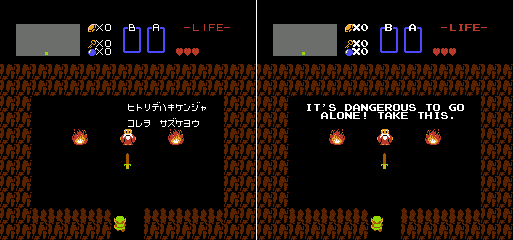 |
In English he says, “It’s dangerous to go alone! Take this.”
He says pretty much the same thing in Japanese: “It’s dangerous to go alone. I’ll give you this.” He also says it an “old wise man” sort of way, although that doesn’t come across in the English for the reasons listed above.
You’ll also notice that in the Japanese game, the text is positioned differently – it starts printing right above his head. It does this with all the other text in the game, too. This style choice was probably meant to act like a speech bubble in a comic, only without a bubble. But since it usually takes a lot more text to convey things in English, the translated text takes up all the blank space above characters in the NES game.
I personally find the English way a lot more aesthetically pleasing, although I can appreciate what the Japanese version was going for.
I should also point out that all the Japanese text in the game uses katakana, and if you’ve studied Japanese you’re probably asking yourself, “Why would they do that? That’s a strange choice.” It’d be kind of like if an English game could only use an uppercase or a lowercase alphabet, and the programmers decided to go with the all-lowercase alphabet.
Presumably it was done due to technical limitations, though I don’t have a specific source on that. I guess I’m mostly unsure why they’d only use one type of kana when other games of the era were able to use both hiragana and katakana. Especially given that this game was being specifically touted for the amount of content that was packed into it, thanks to the Famicom Disk System.
Shop Guy
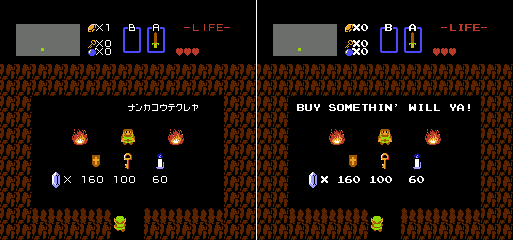 |
One of the shopkeeper lines in the NES version goes, “Buy somethin’, will ya!”
The Famicom line says the same thing. In fact, he even speaks it in a non-standard way in Japanese too – he says it in a western Japanese dialect.
For some interesting reason, the natural translator tendency is to translate this sort of dialect by changing the “-ing” endings of English words to “-in'” and loosening words like “for” to “fer” and “you” to “ya”. That’s what’s happening here in the English translation. So the localizers did a good job here of trying to bring that “non-standard, less formal” style across. It’s kind of impressive – you don’t usually see that level of care given to text this early on in console game translations.
Heart or Potion?
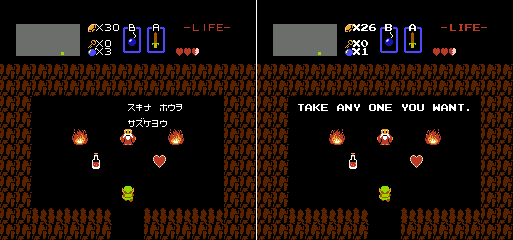 |
In the NES version, this old man says, “Take any one you want.” when you’re allowed to choose between a potion and a heart container.
In the Japanese version it’s basically the same, kind of like, “I’ll give you whichever one you want.”
The Japanese word choice does give a sort of old wise man vibe which is lost in the English translation.
White Sword Guy
 |
In the NES version, the old man at the top of the waterfall who gives you the White Sword says, “Master using it and you can have this.”
The Japanese version is something like, “If you can use this masterfully then I will let you have it.”
I really like how the English version is able to condense it all down – good translation is often about economy of words, and it does it well here. My only nitpick is that it sort of implies that you need to practice using it before he’ll let you keep it. But that’s not what he means at all.
Neither version really makes it clear that you need to have a minimum number of hearts to use it. I guess the idea it was trying to get across was, “Beat enough dungeons and get enough experience and you’ll be able to use this at some point.” rather than trying to explain the underlying game mechanic details.
Hint Lady
There are a couple hint ladies throughout the game, and you have to pay them the right amount of money to get a hint out of them. This particular lady is the one in the waterfall near the top of the map.
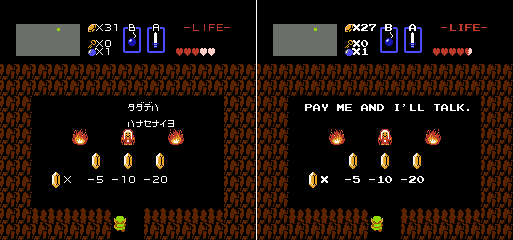 |
In the NES version, when you first see her, she says, “Pay me and I’ll talk.”
In Japanese, she says something more like, “I won’t talk for free!”
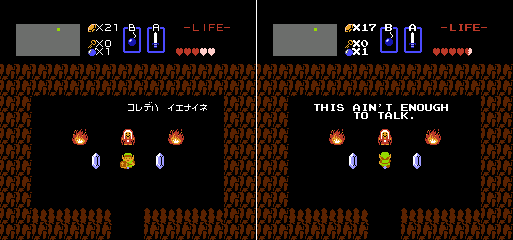 |
If you choose to give the lady the wrong amount of money, she’ll say in the NES version, “This ain’t enough to talk.”
Her line in Japanese is pretty much the same, “This isn’t enough to make me talk.”
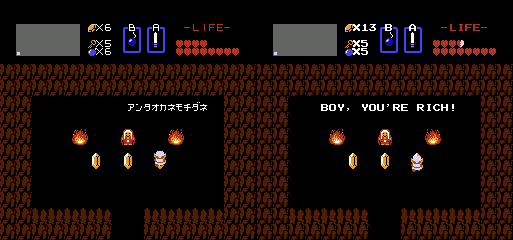 |
If you give her too much money, she says, “Boy, you’re rich!” in the NES version.
She says the same thing in the Japanese version: “You sure are rich!”
Basically, the “boy” in the English translation isn’t her calling Link a boy, she’s showing her amazement. I don’t think that was ever in question, but it’s an example of how it’s possible to read a line of translated text in two slightly different ways.
The Japanese line also has an old lady nuance to its wording. I can just hear an old lady saying it with that exact same wording in real life 😛
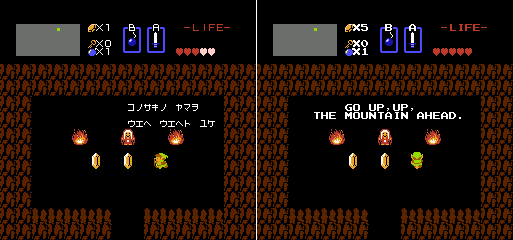 |
If you do choose the right amount to give her, she’ll say in the NES version, “Go up, up, the mountain ahead.”
In the Japanese version she says almost the same thing. The only thing I might nitpick is that the way she phrases it here (“上へ 上へと”) equates more to “way up” in English. So something like, “Go way up the mountain ahead.” might’ve been a better translation. The official translation makes you think you need to go up, and then up again to reach the secret entrance to Level 5. But you actually need to go up four or so times to reach it.
Level 1 Old Dude
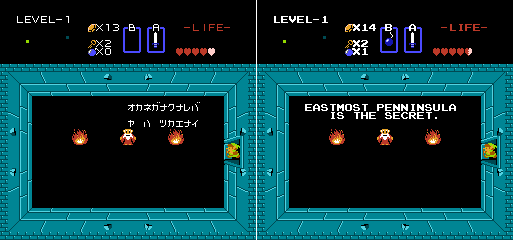 |
The old man in Level 1 has a hint for you. In the NES version, he says, “Eastmost penninsula is the secret.”
Now that I think about it, what is this hint even talking about? Is it referring to the Moblin in the top right corner of the map who gives you the 100 free Rupees, or something else?
Anyway, with such a strange-sounding line in English, you might think it was just a goofy translation by a non-native speaker… Nope! The Japanese text actually says: “You can’t use arrows if you run out of money.”
I’m not sure why this was changed in the localization – the arrow hint is actually a really useful and important gameplay tip, especially since you get the bow in this very same dungeon.
So basically, the famous “Eastmost penninsula is a secret.” line was made up out of nowhere and isn’t a translation of what the original game says. Yet somehow it even includes spelling and grammar issues!
Incidentally, this line is famous among English-speaking gamers for how “broken English” it sounds. It gets quoted a lot, sometimes even in other games:
 |
Expensive Guy
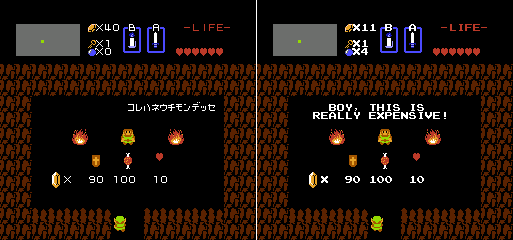 |
Another shopkeeper says in the NES version, “Boy, this is really expensive!”
In the Famicom version he speaks in a western Japanese dialect, saying something like, “This is a good value!”
I guess the “boy” thing was the attempt at conveying the non-standardness of the dialect, although it doesn’t work that well. It definitely shouldn’t say “expensive”, though. He’s essentially trying to say, “This is a good value and worth buying.” Which is why he says this when something is an especially good deal at his shop.
Money Moblin
 |
Another famous line in the NES translation of Zelda is, “It’s a secret to everybody.”
The Japanese line isn’t as unique though, it’s a pretty common phrase and translates to something like, “Now keep this a secret from everyone!”
Letter Man
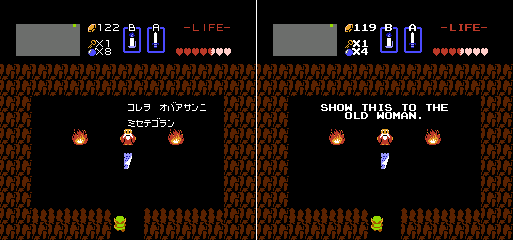 |
In the NES version of Zelda, this old man gives you a letter and says, “Show this to the old woman.”
He’s referring to an old woman (or is it multiple old women?) who sits in a cave silently. Giving the letter to her will get her to sell you life potion.
The Japanese version of this text is the same. Though I guess if you wanted to get super-technical, it’s more like, “Show this to the old woman and see what happens.”
Medicine Lady
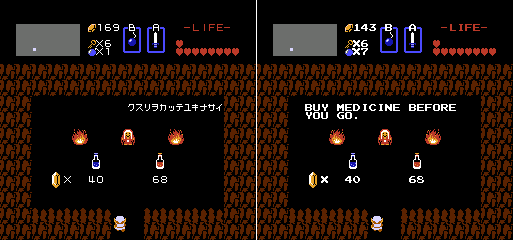 |
The old potion lady says in the NES version, “Buy medicine before you go.”
In the Japanese game, she says something like, “Buy medicine and be on your way.” It’s essentially the same as the English version, although in Japanese she also says it like an old person might.
Mr. Money Maker
 |
Another truly iconic line from the NES translation is from an old man who says, “Let’s play money making game.” It’s famous mostly because it just sounds so poorly translated.
The Japanese version lacks that strangeness and has proper grammar and everything, making me wonder if it’s as famous over there. In any case, what he says is, “Want to play a game where you can increase your money?” The concise “Want to play a money-making game?” would’ve been perfect for the NES translation, but maybe in the end the weird line made it more memorable 😛
Grave Lady
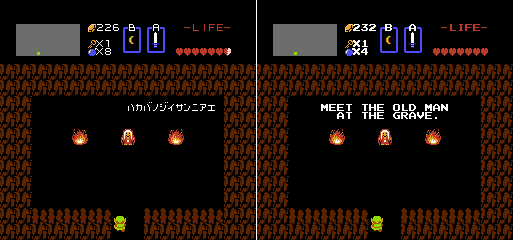 |
This old lady says in English, “Meet the old man at the grave.”
It’s basically the same in Japanese, but technically it’s more like, “Meet the old man in the graveyard.”
The English version also sort of gives the impression there’s just one grave in the game, though once you’ve visited the graveyard you realize that’s not the case.
Smoke Guy
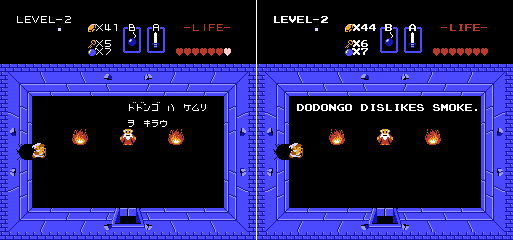 |
Another famous line from the English translation of Zelda is from this old man in Level 2 who says, “Dodongo dislikes smoke.”
I remember finding it amusing as a kid, but looking at it now I’m not sure why anymore. Maybe it just sounded random or something.
Anyway, I was curious to find out what he says in the Japanese version. It turns out he says the same thing, something like, “Dodongo hates smoke.” I might even say that it should be plural, since there are so many in the game, making it, “Dodongos hate smoke.”
Old Repair Man
Sometimes if you uncover a secret cave in the overworld, an old man inside will force you to pay for the repair costs.
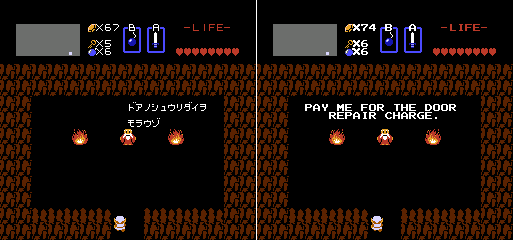 |
In the NES version he says, “Pay me for the door repair charge.”
In the Japanese version it’s pretty much the same, I guess technically he says something like, “You owe me for the door repairs.” or “I’ll be taking money for the door repair charges.”
In Japanese, he says it in a forceful, masculine way, too.
Sword-id Guy
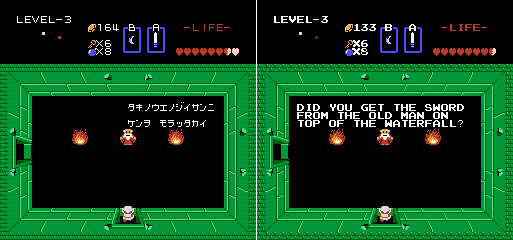 |
In Level 3, an old man says in the NES version, “Did you get the sword from the old man on top of the waterfall?”
The Japanese text is the same. But it’s also said in a way that one might associate with an older person, at least in the context of this game.
Dead End Geezer
 |
Another hint-giving old man says in the English version of the game, “Secret is in the tree at the dead-end.” This is another case of awkward sounding English, so it’s another somewhat famous line among English-speaking gamers.
In Japanese, he’s saying basically the same thing, but with proper grammar and all that. He says, “There’s a secret in a tree at a dead-end.”
Waterfall Guy
 |
An old man in Level 4 tells you in the NES game, “Walk into the waterfall.”
In Japanese, he says the same thing. It’s such a simple line that it’d be almost impossible to mess up 😛
Lost Woods Lady
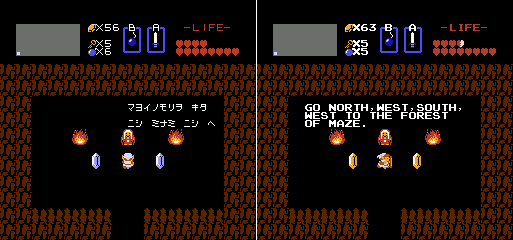 |
An old lady in the southwest area of the map says in English, “Go north, west, south, west to the forest of maze.” The non-native phrasing gives you the impression that following these directions will take you to a “forest of maze”.
The translation of the Japanese would actually be something like, “Go north, west, south, and west in the Lost Woods.”
This was the first time the Lost Woods (called the “Mayoi no Mori” in Japanese) appears in the Zelda series, but the English translation completely botched it. If it had at least been called the “Maze Forest” it still would’ve been okay.
Also, the use of “to” instead of “in” here is due to someone mistranslating the Japanese particle “o/wo”, which can mean many different things depending on the context. How to translate it would be clear to a native English speaker, not necessarily so to a non-native. So it sounds like a non-native speaker translated this line.
Given that Nintendo of America clearly went in and gave the game’s text a lot of attention – even enough to make new hints – it’s surprising that they still let a poor line like this fly.
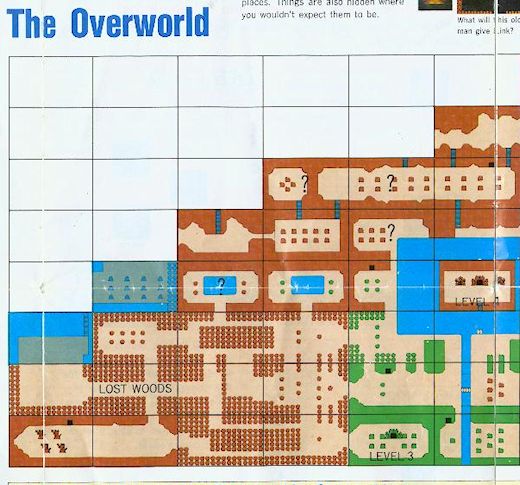 |
In the end, though, I think most English-speaking kids could figure out that you needed to go north, west, south, and west to get out of the Lost Woods. Speaking of which, at first I wasn’t even sure how we kids knew to call the place the “Lost Woods” back then, but apparently the map included with the game called it that. So it looks like this is a case of the game’s text and the supplemental material’s text not quite matching.
Magical Sword Man
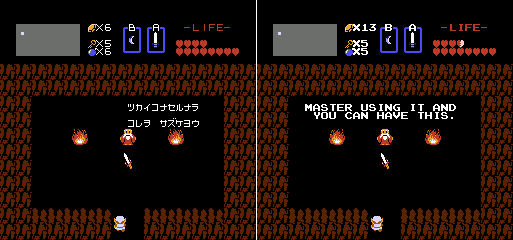 |
The old man with the Magical Sword says the same thing the old man with the White Sword says. I always wondered if he might’ve said something different in the Japanese version, but nope, it looks like it’s the same line in the Japanese version too.
Digdogger Expert
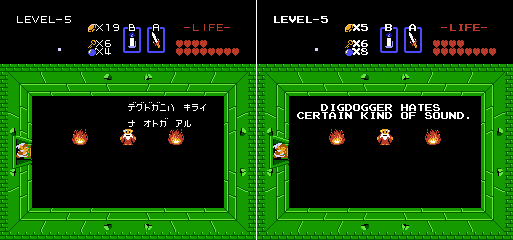 |
In the NES version, this old man in Level 5 says, “Digdogger hates certain kind of sound.” This and other instances of poor grammar were fixed in later releases of the English version.
The Japanese version is basically the same, “There’s a sound that Digdogger hates.” or possibly, “There’s a sound that Digdoggers hate.” Personally, I’d go with the latter one, since there are multiple Digdoggers throughout the game.
Bomb Man
 |
In a few places in the game, an old man offers to increase your maximimum bomb capacity. In the NES version, he says, “I bet you’d like to have more bombs.”
The Japanese version of this isn’t really any different, another translation might be, “You’d like to have more bombs, wouldn’t you?” The English translation is just fine, the main thing of interest here is that he clearly talks like an old man in the Japanese version – if you took this Japanese line all by itself and showed it to someone, they’d be able to tell instantly that an old person was saying it.
Enemy Weaknesses
 |
In this secret room in Level 5, an old man says in the Japanese version: “There are some creatures that are weak against sound.”
In the NES version, this was changed to say, “Secret power is said to be in the arrow.”
Both guys are trying to give you a hint that the Pols Voice enemies have certain weaknesses – in the Japanese version they’re weak against real-life sound, and in the NES version they’re weak against arrows. If you missed it, we looked at this gameplay difference in detail here.
Honestly, I find the English version to be poorly done. “Arrow” can mean many things – there’s even a rock formation that looks like an arrow. It makes the intended meaning confusing. Saying “secret power” isn’t very helpful either – even if players do figure out that he’s talking about the bow and arrow item, “secret power” doesn’t really explain that you need to use it on Pols Voice enemies specifically. I’m sure people figured it out eventually, it’s just not very effective as far as hints go.
So again, a made-up English hint turns out to be poorly worded and not that helpful.
Hit the Road
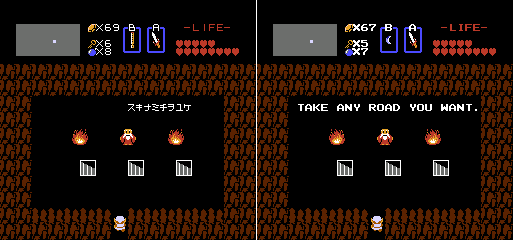 |
An old man greets you when you enter one of the shortcut caves. In the NES version he says, “Take any road you want.”
The Japanese is the same, although I personally would have translated it as, “Take any path you want.”
Eye of the Spider
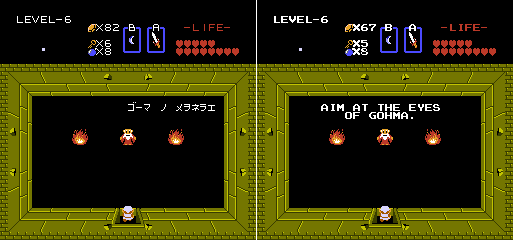 |
This old man in Level 6 tells you in the NES game, “Aim at the eyes of Gohma.”
The Japanese hint is essentially the same.
The issue here is that Japanese makes no distinction between singular and plural nouns. This can cause trouble in translation sometimes, such as this case. It’s a problem because Gohma only has one eye!
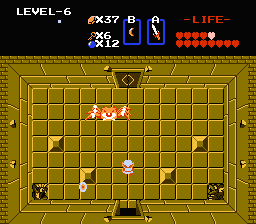 |
So a better translation would’ve been, “Aim at the eye of Gohma.” or “Aim for the eye of Gohma.”
Fairy Man
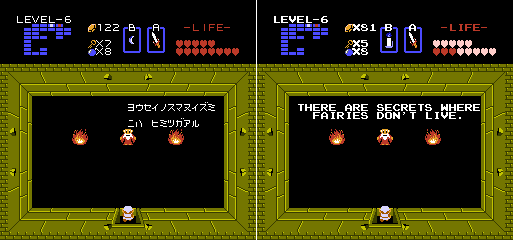 |
This other old man in Level 6 says in the NES version, “There are secrets where fairies don’t live.”
The Japanese version is more like, “There’s a secret in the pond without a fairy.” or “There’s a secret in the pond where a fairy doesn’t live.”
This is supposed to give the player a hint about where to find the entrance to Level 7. The English version is okay, but the Japanese version is much clearer and more helpful.
The Secret Nose
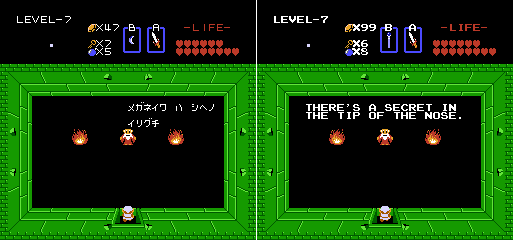 |
This old man in Level 7 says in the Japanese version: “Spectacle Rock is an entrance to death.”
In the NES version, he instead says, “There’s a secret in the tip of the nose.”
That’s quite a difference. I’m assuming he’s referring to a room in Level 7, but that’s not very helpful. You can find all the rooms in the dungeon just by checking the map.
Incidentally, “Megane Iwa” is the Japanese name for Spectacle Rock. “Megane” usually means “glasses”, so the choice to use “spectacle” instead was a good and interesting choice by the localizers.
Hungry Goriya
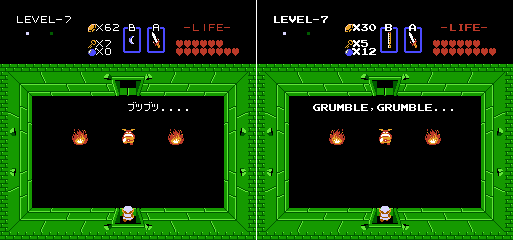 |
In Level 7 is a Goriya who says nothing but, “Grumble, grumble…” He blocks the way too, so you have to figure out a way to get past him somehow. It turns out you have to buy some food to give to him. How kids are supposed to know that is beyond me – there are no other hints about it at all in the game.
One idea I had was that maybe “grumble” was his stomach grumbling… But nope, the Japanese text is exactly the same. He’s literally grumbling/muttering to himself. I found that surprising, I always thought this was a messed-up translation.
Death Mountain Hint
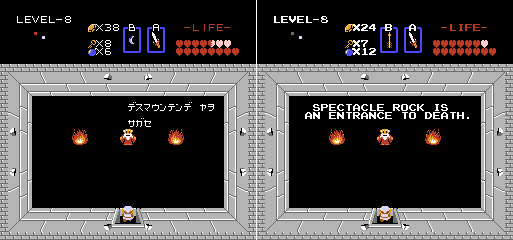 |
In Level 8, this old man says in the Japanese version, “Look for the arrows in Death Mountain.”
In the NES version, he instead says, “Spectacle Rock is an entrance to death.” Wait, what? An old man in Level 7 said that in the Japanese version! What gives?
I can only think that they added in the “secret is in the nose” tip out of nowhere for Level 7 and accidentally pushed a bunch of other hints forward in the process, or they purposefully rearranged hints for whatever reason.
What’s weirder is that “Look for the arrows in Death Mountain” is a huge hint. You can’t defeat Ganon and complete the game without the arrows, but now you don’t even know that you need to be looking for them. It’s very strange that Nintendo would take out such an important tip like that.
Insane Old Man
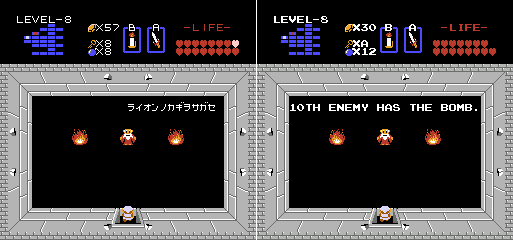 |
Another old man in Level 8 says in the NES version, “10th enemy has the bomb.” When I saw this hint, I was like, “Wait… what? What kind of hint is that?!”
You would think he means to go around and kill enemies and that every 10th enemy would give you a bomb. That’d be nice if it were true, but it’s not. So what the heck is he talking about?!
Well, many readers have sent me messages saying that if you can defeat nine enemies in a row without getting hit and then kill a tenth enemy with a bomb THEN you’ll get a bomb item. It took me 25 years and the invention of the Internet to figure that out… Clearly this wasn’t a very helpful in-game hint!
Anyway, years later, armed with Japanese knowledge, I learned that this old man is actually saying, “Search for the Lion Key.” in the Famicom version. Now that’s a useful tip!
Why did Nintendo take out yet another helpful hint? And why replace it with something so nonsensical? It’s a secret to everyone.
No Triforce No Service
If you try to explore the final level without getting all the Triforce pieces, you’ll run into an old man blocking the way.
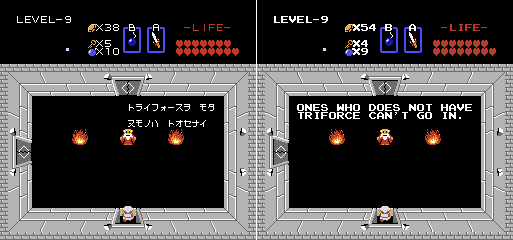 |
He says in the NES version, “Ones who does not have Triforce can’t go in.”
In the Japanese version he says essentially the same thing. His line also sounds like one a old wise man would say, so I probably would’ve phrased it more like, “Those without the Triforce cannot pass.”
The English version gets the point across just fine, but it suffers from grammar problems. These were fixed in later releases of the English version. Still, with so little text in the game, I’m surprised the translation had this many problems.
As we’ve briefly seen earlier, later English versions of the game fixed some of the text. Here’s what this guy says in the GBA port, for example:
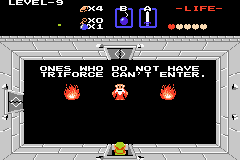 |
We can see that the grammar issues were finally cleaned up somewhat. I personally would’ve added a “the” or an “a” before “Triforce”, though.
Skull Eyes
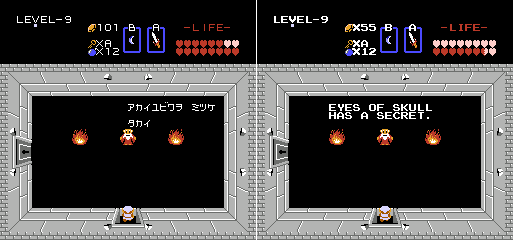 |
This old man in Level 9 says in the NES version, “Eyes of skull has a secret.”
In the Famicom version, he says, “Have you found the Red Ring?”
So this is another case of the localizers making something up out of nowhere – and somehow making another grammar mistake in the process.
I feel like the Japanese hint is a lot more helpful – it tells you that, “Yes, the one item you couldn’t find yet is here in this dungeon. And I suggest you get it, too.”
By this point in the game, any decent player would know to try to enter the blank rooms on the map, so the English hint isn’t that helpful at all. One of the “eyes” isn’t even a secret – it’s where Zelda is after you beat Ganon, so you end up visiting it anyway!
Next Door Neighbor
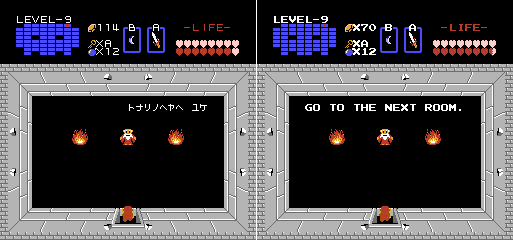 |
This old man in Level 9 says, “Go to the next room.”
He says the same in the Japanese version, nothing especially notable here. But it’s interesting that they left this line alone after changing all the other recent lines.
Wacky Old Man
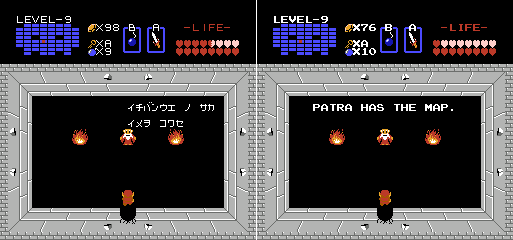 |
This other old man in Level 9 says in the NES version, “Patra has the map.”
I think by the time you get here, you probably already have the map, and if you don’t, you’re probably like, “Uhh, who’s Patra?” It turns out Patra is one of those weird flying eye enemies, but why make this a hint? By now it’s common knowledge that major enemies sometimes drop key items.
It turns out that in the Japanese version, he actually says, “Destroy the topmost boundary.”
Apparently he’s giving you a hint on how to find the Red Ring up in the top-right corner of the level, but it’s definitely a pretty vague clue that could mean all sorts of different things. I don’t know, maybe that’s why this hint was changed for the NES version.
Saving the Day
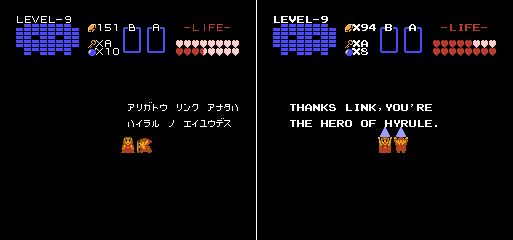 |
The ending text when you save Zelda is basically the same in both games: “Thanks, Link. You’re the hero of Hyrule.”
Right after this, the NES version will say, “Finally, peace returns to Hyrule. This ends the story.”
The Japanese is essentially the same, along the lines of, “And so peace returns to Hyrule. Thus ends this tale.”
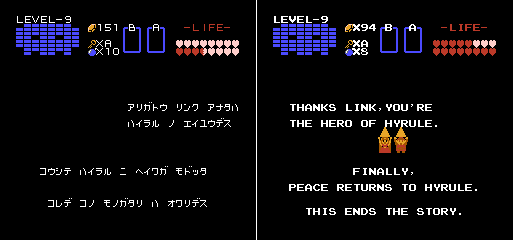 |
But the real point of interest is that the Zelda, Link, and Triforce graphics all disappear in the Japanese version when this text appears. I wonder why.
Credits
I remember being curious about the names in the credits when I first finished the game as a kid. The names just sounded weird and goofy. Plus, once I learned Japanese, I realized that “Miyahon” was likely an intentional mis-transcription of “Miyamoto”. It’s hard to explain why unless you know Japanese kanji.
Anyway, I was always curious to see what the Japanese credits were like, it turns out they’re the exact same:
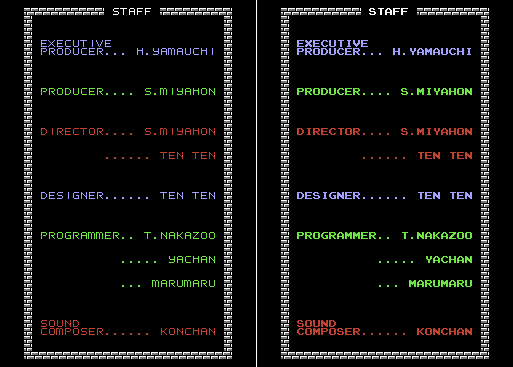 |
For reference, here’s what the credits should really say:
| Executive Producer | Hiroshi Yamauchi |
| Producer | Shigeru Miyamoto |
| Directors | Shigeru Miyamoto Takashi Tezuka |
| Designer | Takashi Tezuka |
| Programmers | Toshihiko Nakago Yasunari Soejima I. Marui |
| Sound Composer | Koji Kondo |
Apparently it was very common for game developers to use pseudonyms back then to keep rival companies from trying to hire all the good talent away. As a result, Japanese games from this era have some really crazy names in the credits, like “FISH MAN” and “YUUKICHAN’S PAPA”.
Ending
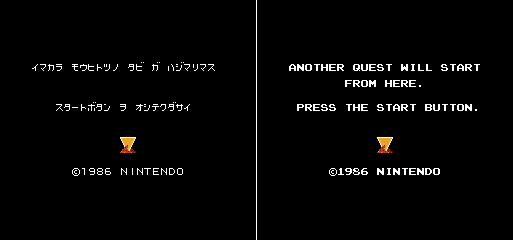 |
The final screen in the game is basically the same in both games, but for sake of reference, the NES version says, “Another quest will start from here. Press the Start Button.”
The Japanese version translates to something like, “Another quest will start now. Please press the Start Button.”
- Detailed information about the original translation, the quietly revised 2003 translation, which ports/re-releases use which translation, and tips on how to identify which translation you’re playing
- Further information on Japanese speech styles, including simple examples of different speech styles from famous games
- Greater detail about Japanese dialects, including a complete map of the 20 major dialect regions
- A peek at how Zelda I’s text translation compares with Zelda II’s
- A note about games being revised after release
- The legacy of “It’s a secret to everybody.” and examples of how it has appeared in many other Zelda games since
- A connection with A Link Between Worlds that offers a potential new meaning to “It’s a secret to everybody.”
- A look at preserving speech styles in localization
- A couple neat little tricks
- A deeper analysis of the “dead end tree” hint
- More about the Lost Woods
- More about the hint to reaching Level 7, and its Nintendo Power connection
- The legacy of the “Spectacle Rock” localization choice throughout the early Zelda series
- A look at the prototype Japanese version of the game, its relation to the final Japanese/English hints, and how the beta text solves some of the mysteries of the final script
- A quick look at how Nintendo of America tried to engage players outside of the game after saving Princess Zelda
- Further information about Japanese pseudonyms in game credits
- An investigation into I. Marui’s true identity







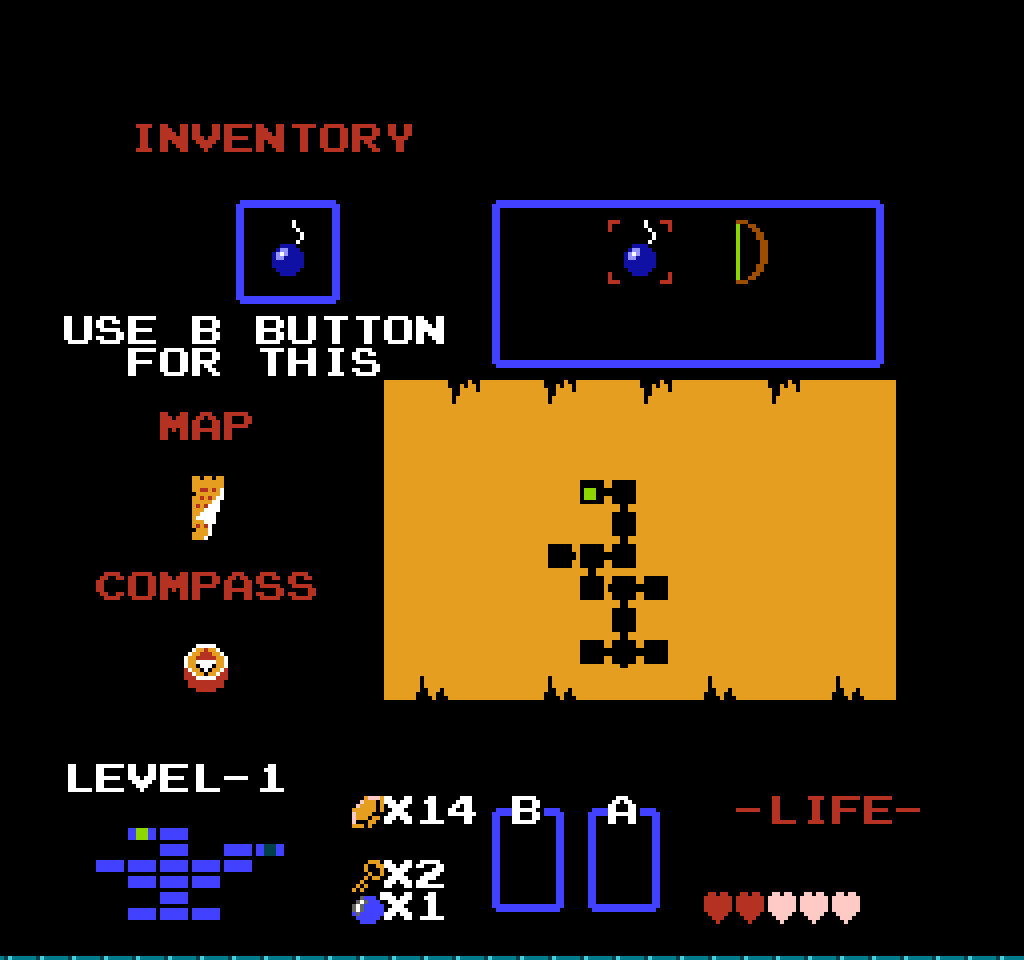
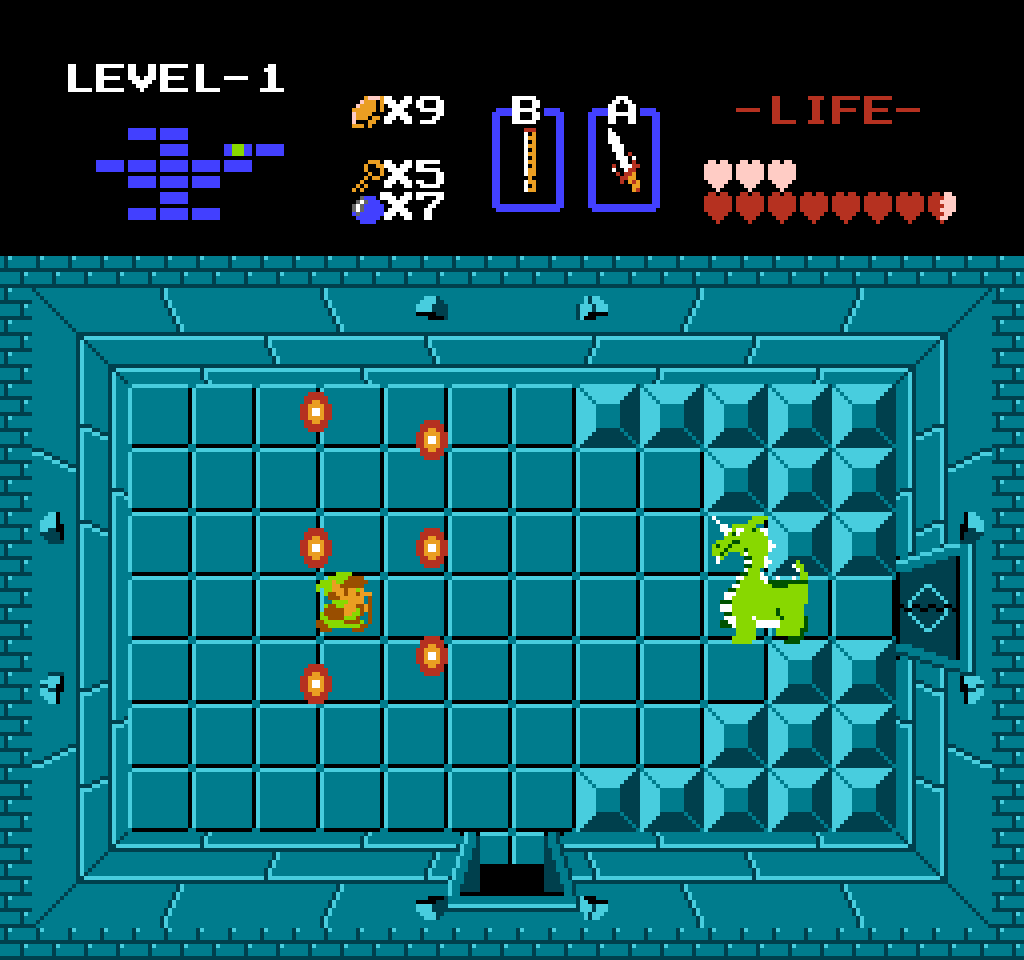
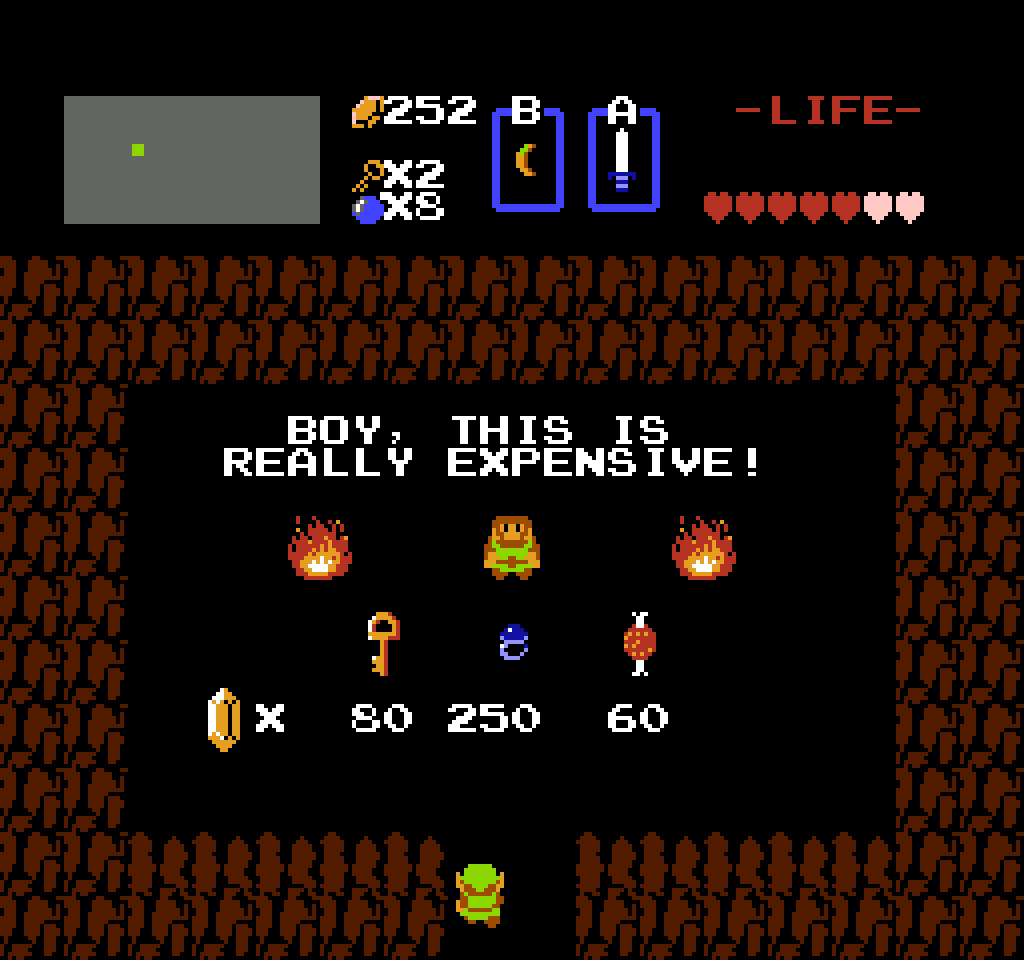
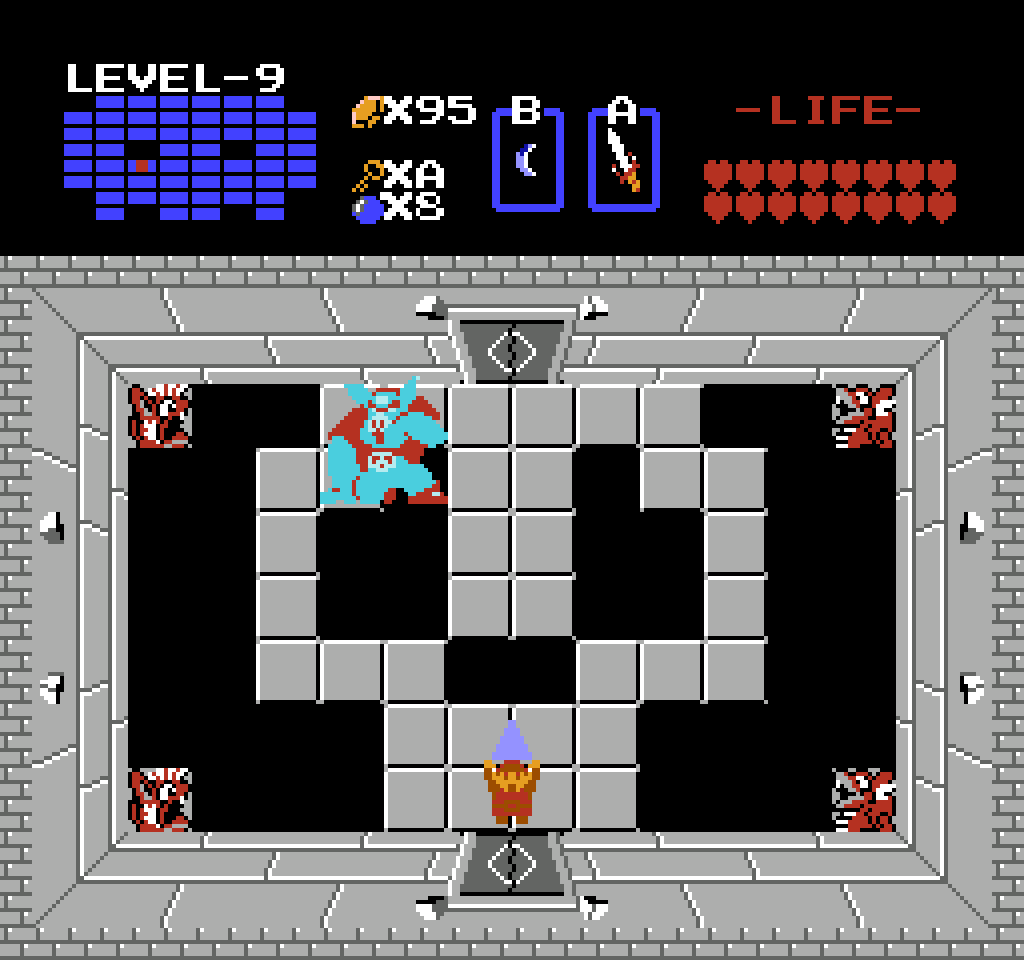

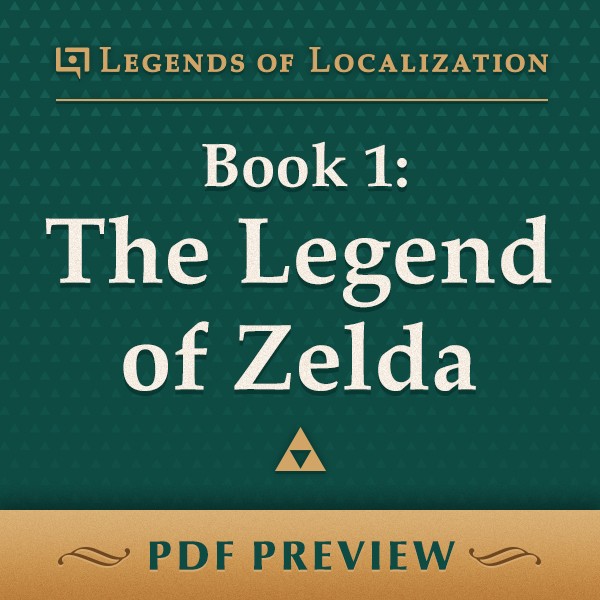
No Comments